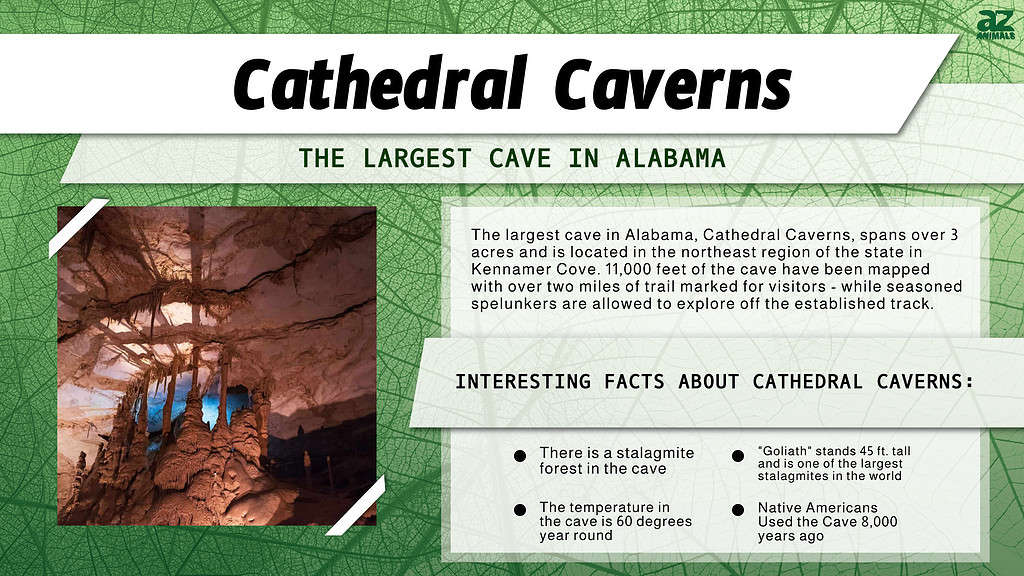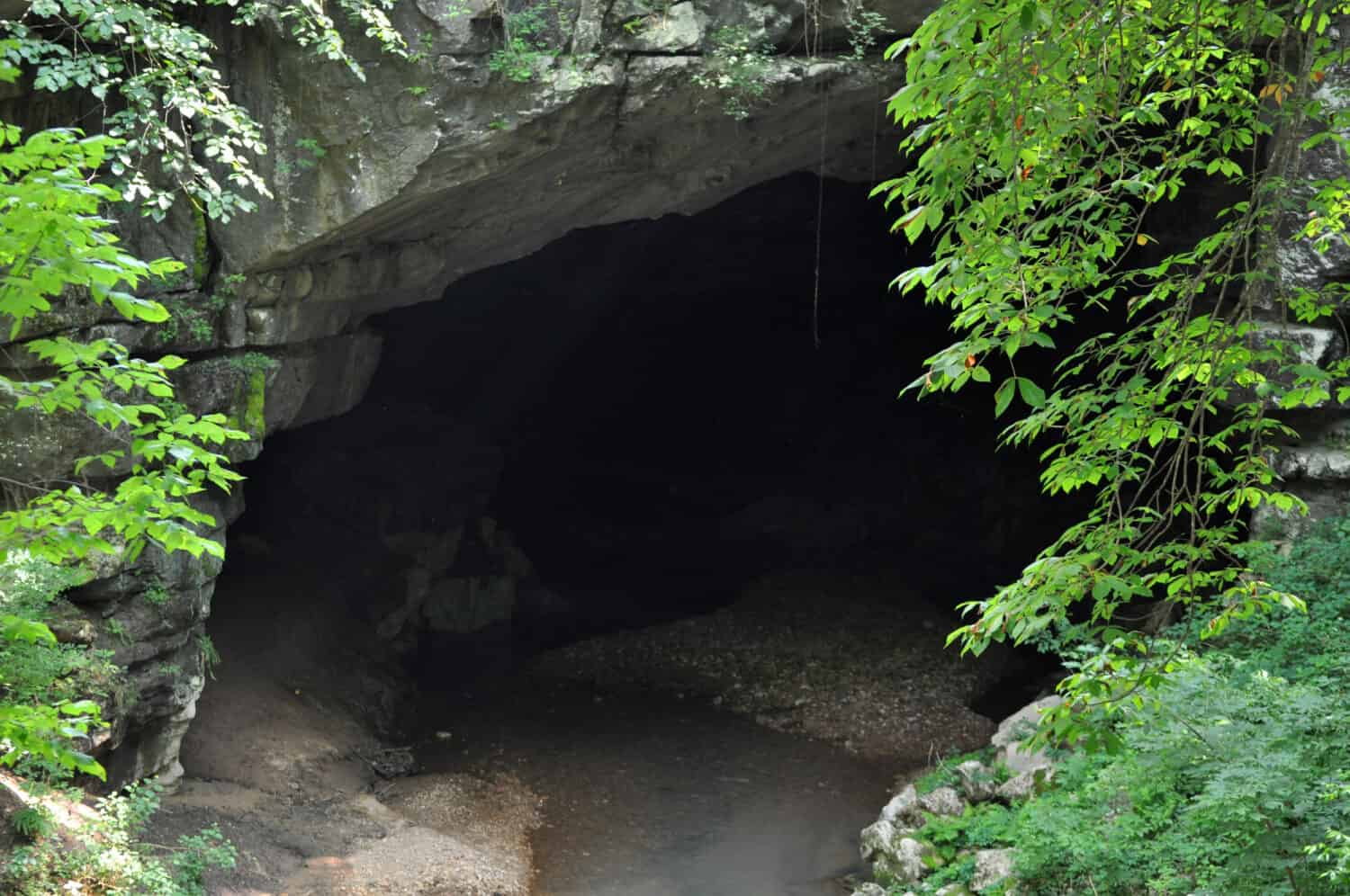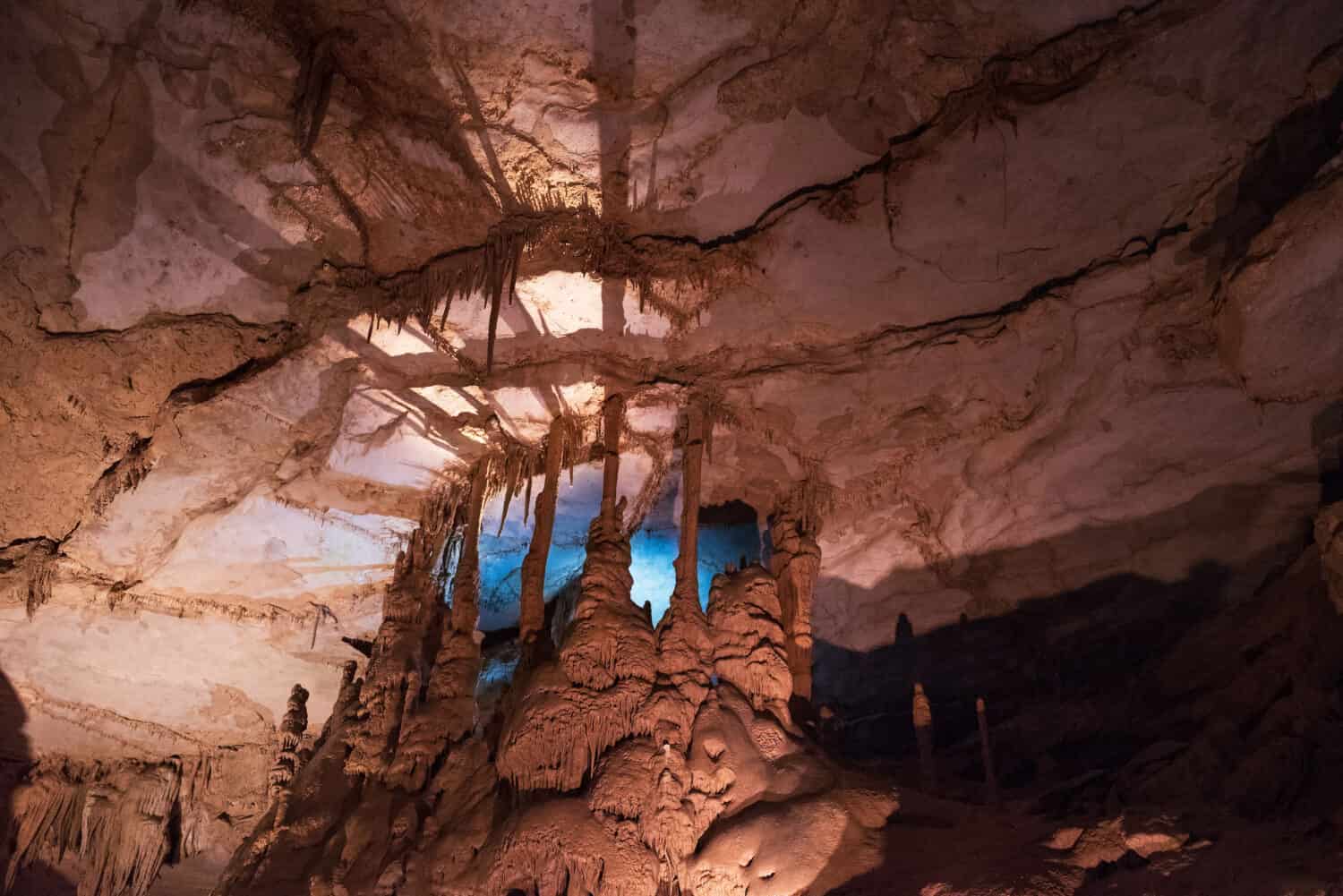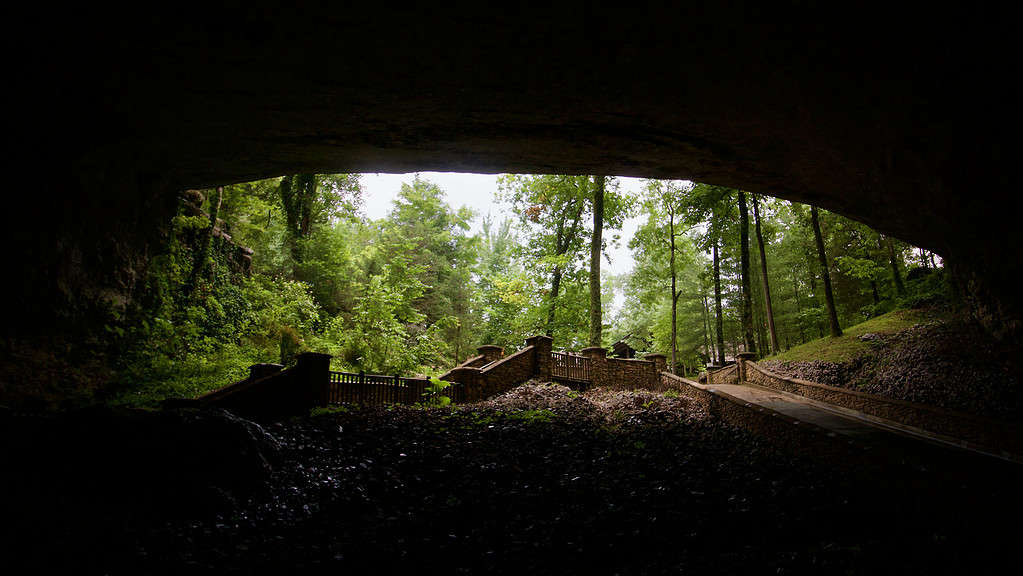Natural wonders abound in Alabama; it’s not surprising that one of the state’s tourism slogans is to “Share The Wonder.” The Yellowhammer state is home to the longest natural bridge east of the Rockies, a rock arch named Natural Bridge, and it has a rich cave system.

From the first officially recorded cave in the U.S, Majestic Caverns (DeSoto Caverns) in Childersburg, to the Stephens Gap cave, described as one of the country’s most photographed wild cave scenes, the state boasts many awe-inspiring sights to the delight of spelunkers.
Alabama is the 30th largest state by area, with a total area of 52,420 square miles (135,767 km2), and the 24th-most populated, with 5.74 million inhabitants as of the 2020 census. According to the 2007 Alabama Cave Survey, over 4,200 caves have been discovered in the Heart of Dixie.
Why Are There So Many Caves in Alabama?

Alabama has many caves that were formed over millions of years.
©SaraJo/Shutterstock.com
Caves are geologic features that develop in karst rock units, created when slightly acidic rainwater weakens soluble bedrock. Caves, sinkholes, and receding streams result from flowing water in karst regions.
The Mississippian limestone, the rock type that contains many Alabama caves, was deposited between 320-350 million years ago, during the Carboniferous geologic period, when much of what is now Alabama was submerged under a shallow sea.
Due to the water-soluble nature of this rock, caverns form when slightly acidic groundwater seeps into the limestone’s natural cracks and crevices.
Northeast Alabama is a “hotspot” for caves in the United States because of the abundance of caves and the variety of species that live within. About two-thirds of the state’s caves are located in this area. However, many other state regions have the carbonate rock bed geology required to form caves.
Northeast Alabama is a part of the “TAG” area, an acronym for the karst-rich terrain in southeastern Tennessee, northern Alabama, and northwestern Georgia.
Caves are located in three main geographical areas of the state. One is the Tennessee River Valley region, where the Tennessee River and its streams break down carbonate rock and form caves. It’s a good place to mention that Alabama shares borders with Tennessee to the north.
The Coastal Plain region has the least number of caves, and it’s where caves were discovered in limestone bed outcrops. The Valley and Ridge section is part of the southern reaches of the Appalachian mountain system and the renowned TAG area.
The National Speleological Society, established in 1941, moved its headquarters to Huntsville in 1971 because of the abundance of caves in the state. Thus, Alabama became a leader in the research of subterranean ecosystems.
The geologic features of Alabama caverns are significant, but they also support distinctive animal species. Troglobites, such as cave salamanders, evolved specifically to survive in the dark environment of caves. Animals known as subtroglophiles and trogloxenes can live both in subterranean habitats and outside – such as bats and cave swallows.
They are distinct from troglobites because they are not evolved to live in a cave permanently. Instead, they can survive in a suitable habitat outside of the cave.
Trogloxenes periodically live in underground habitats or at the entrances of caves, but cannot live there exclusively. Bats, rats, bears, and raccoons tend to sleep in caves and spend the rest of their time outdoors.
The Largest Cave in Alabama
Cathedral Caverns is the largest cave in Alabama. It’s within the Cathedral Caverns State Park, a public leisure area and natural history preserve in Kennamer Cove, Alabama. It lies roughly 5 miles (8 km) northeast of Grant and 7 miles (11.2 km) southeast of Woodville in Marshall County.
The Karst cave spans about 3 acres (1.2 hectares). Nearly 3,500 feet (1066.8 m) of wheelchair-accessible, 8-foot-wide (2.4 m) concrete pathways and 2 miles (3.2 km) of trails make up the public area of the cave. An additional 2,700 feet (822.9 m) stretch beyond the end of the pathway.
Approximately 11,000 feet (3,352.8 m) have been mapped; only seasoned cavers are permitted to venture off the established track. With its famed entrance measuring 25 feet (7.6 m) high and 128 (39 m) feet across, Cathedral Caverns has the world’s widest opening to a commercial cave.
A paved and well-lit route leads to Cathedral Caverns, which stays at 60 degrees all year. Its largest chamber, the Big Room, is 200 feet (60.9m) wide and 792 feet (241 m) long.

The caves at Cathedral Caverns maintain a regular 60 degrees all year.
©FotoNero/Shutterstock.com
The cavern features a large stalagmite forest and 45 feet (13.7m) tall, 243 feet (74 m) in circumference Goliath, one of the largest stalagmites in the world. Goliath is a column that connects a stalagmite and a stalactite. From the cave floor, a stalagmite emerges, while a stalactite forms downward from the ceiling.
There’s another stalagmite, known as the Devil’s Broomstick, with a base diameter of 3 inches which rises from a rock formation to the cave ceiling 35 feet (10.6 m) above at a 45-degree angle. Despite the New Madrid Earthquake of 1812, the improbable stalagmite survived.
A 32-foot (9.8 m) tall, 135-foot (41 m) long frozen waterfall-like flowstone is here as well. The Crystal Room is a delicate area of pure white calcite in the cavern that is off-limits to visitors. The calcite may tremble and crack at the slightest vibration from a person’s voice.
Historical Context
The caverns were created within limestone from the Mississippian geologic age deposited between 350 and 320 million years ago and are situated in the Cumberland Plateau physiographic area of Alabama. Archaeological research at the cavern’s entrance suggests that Native Americans used the cave 8,000 years ago.
The Kennamer family settled the region around the caverns, which later became known as Kennamers Cove. The family resided in the cave for a long time during the Civil War when Union troops set their farmhouse on fire.
From 1955 through 1974, local businessman Jacob “Jay” Gurley ran the cave, which was formerly known as Bats Cave, as a private tourist destination. He made improvements such as laying up walkways and adding lighting.

The entrance of the Cathedral Caves has been improved with the addition of walkways and lighting.
©Diegoandrade /CC BY-SA 4.0 – License
Gurley gave the cave its current name after his wife said that the cave’s stalactites and stalagmites resembled cathedrals.
It was designated a National Natural Landmark in June 1972 and auctioned to Tom German about three years later. Tom added amenities like a gift shop, picnic spaces, and tables for rent. In addition, he opened a new area of the caverns to guests and upgraded the lighting.
The state acquired the cave and 461 acres of surrounding land in 1987. Although funding issues delayed the state’s plans, restoration work started in 1995. The public was again allowed access to the cave as a state park in May 2000. The Alabama Department of Conservation and Natural Resources manages it.
The horror movie Secrets of the Phantom Caverns used the cave for its primary photography in 1983. It was also the cave setting for the 1995 Disney Studios film Tom and Huck.
Where Are The Cathedral Caverns Located on a Map?
Cathedral Caverns State Park is a place for the public to enjoy and learn about nature. It’s found near Kennamer Cove, Alabama, around 5 miles northeast of Grant and 7 miles southeast of Woodville in Marshall County. This park was actually originally called Bats Cave and became a popular tourist spot in the 1950s.
Here it is on a map:
Visiting the Cathedral Caverns
The interior parts of this underground wonderland are open to guided trips for nature lovers and adventure aficionados. The typical tour duration is 90 minutes, with a 1.5-mile round-trip distance. Unfortunately, only one tour is available at the Cathedral, not a variety as they have in some other caves.
During the week, you can visit the Cathedral Caverns, but you must reserve your spot 48 hours in advance. Calls to reserve a spot on a tour must be accompanied by a nonrefundable full payment.
Tour groups match 50% of the cavern’s capacity. Be sure to arrive at least 15 minutes before the start time to finish any last-minute preparations.
As prices can change without warning, it is best to check with the information desk about any modifications or special deals. Children aged four and under are admitted free of charge when accompanied by an adult. Those between 5 and 12 pay $9, while those 13 and above pay $20. Military personnel pays $2 less than the latter age range.
The cost for schools is $8 for kids and $15 for chaperones. Teachers who visit with a school group should check with the information desk if they qualify for free admission.
The cave and other structures in the park are off-limits to pets.
Wildlife at the Cathedral Caverns State Park

Carolina
chickadee
s are among the wildlife seen outside Cathedral Caverns.
©Ami Parikh/Shutterstock.com
Some wildlife species often seen in the woodlands of North Alabama also exist at the park. Examples include northern cardinals, raccoons, bald eagles, tufted titmice, deer, woodpeckers, Carolina chickadee, turtles, American kestrels, squirrels, and eastern phoebe.
Animals, plants, and marine plants live in the cavern, making it a biodiversity hotspot. It hosts a range of bat species, the most prevalent of which are the big brown and eastern pipistrelle bats. Insects are their main prey, and they hibernate in the winter.
Activities at the Cathedral Caverns State Park
Touring the cavern isn’t all there is to the park. These are other fun things to try.
Gem mining
Gemstone mining is one of the popular recreational activities to do at the park. It’s family-friendly and particularly well-liked by children. It’s available from 9:00 am-5:30 pm.
Each bag or bucket containing mining dirt features information about possible finds and is available for purchase. Costs range from $6-$50 depending on the size and content of the bag or bucket.
It is possible to buy containers that include both fossils and rough-cut stones.
All you have to do is sift through the dirt in the water flowing down the specially designed flumes and then use the gemstone identification display to pinpoint your treasures.
Hiking

The park around the caverns features many hiking trails of different difficulties.
©adriaticfoto/Shutterstock.com
The hiking paths at the 493-acre park total about five and a half miles (8.8km). Each trail has a marker and a color-coded designation to guide hikers on the go. For example, the Cathedral Caverns features a blue, gray, green, and yellow trail.
There is a trail parking space at the trailhead, across from the intersection of the blue and gray trails.
Running
Cathedral Caverns holds a 5k and 15k trail run every November Both novice and expert trail runners are welcome to participate in this race.
A 0.6-mile out-and-back section wide enough for two-way traffic makes up the final 1.2 miles of the 5k and 15k runs through the cave. The decorative lighting will always be on; runners can take glow sticks at the turnaround point.
Camping
Cathedral Caverns State Park offers both tent camping spaces and upgraded campsites. There’s also a backcountry campground for those who want to hike in and backpack. You can find more information on the Alabama State Parks website.
Mysterious River Inside the Cathedral Caverns
The Mystery River traverses the cavern, so named because it has no recognized source. Some channels are prone to flooding during heavy rain because of restricted drainage.
Built-in 1959 and used until 1995, a bridge that Jay Gurley previously used still exists today. However, it has become inundated due to the Mystery River’s constant flooding.
Conclusion
Have you added the Cathedral Caverns to your bucket list yet? You absolutely should! Anyone who loves nature and adventure deserves a chance to explore the natural rock formations and everything else the Cathedral offers.
The photo featured at the top of this post is © Diegoandrade / CC BY-SA 4.0 – License / Original
Thank you for reading! Have some feedback for us? Contact the AZ Animals editorial team.






